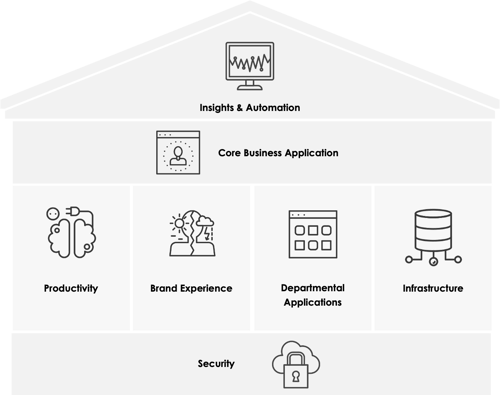Creating a strategic technology roadmap for your organization can seem daunting. It is important to consider all the aspects of your current and future technology investments to ensure you are making the right decisions and achieving maximum returns.
By considering key areas such as prioritizing investment, avoiding laggard states, visualizing gaps, and unlocking hidden potential, you can create an effective tech roadmap that will help guide your business forward.
This blog post is a simple conversation about technology roadmaps and, specifically, a couple of items that continuously come up when our experts at ProServeIT talk to a few customers about the idea of technology roadmaps in general.
In a hurry? Jump straight to your section of interest:
🏠 The ProServeIT House Framework
🗺️ Visualizing and Prioritizing Your Technology Roadmap
🛠️ Creating Your Technology Roadmap
🔍 3 Reasons to Understand Your Organization’s Technology Roadmap
The ProServeIT House Framework
To set the foundation for this conversation, it is helpful to go through the framework used by ProServeIT to build custom technology roadmaps for our customers. When looking at technology for your business, ProServeIT thinks of it through the lens of a House or the analogy of a house.
In our technology house, you (i.e., your organization) should have Security as the foundation of your house and Insights & Automation as the roof (the piece that protects your house), and then multiple different rooms that sit inside your house:
- Your infrastructure
- Your departmental applications
- Brand experience as personified by both customer experience and employee experience
- Productivity
- Your core business application (your most important business application)
When building a technology roadmap, it's important that you focus on not just one of these rooms but all of them.

It doesn't mean your organization needs to over-invest or do a million things per individual room, but you do need to make sure that if you are not going to invest in any of these rooms, you do so intentionally. This way, your organization can avoid slipping into a “laggard” state and continue to meet your business needs as appropriate.
If any of your rooms are in a laggard state, it means your current needs are not being met. For example, your business has outgrown your tools and applications, or the current app version is no longer supported. This usually means there are some "must-do's" to get this area up to date.
The next state is a "fast follower" and this means your current needs are being met but future growth or business changes may not be supported and there are things you "should do" but they're not as urgent.
The most advanced state is "leader" and this means you're up to date and future needs have been planned for, and you're farther ahead than your average competitor. These are the areas you can slow investment in for the time being.
Visualizing and Prioritizing Your Technology Roadmap
To help visualize this, each of these rooms should have a plan, and when you are building out that plan for the year, you can identify itemized projects or milestones that you are looking to accomplish. Some people find it helpful to put dollar figures or budgets into these roadmap sections (see image below).
.png?quality=low&width=762&height=426&name=roadmap%20example-03%20(1).png) As mentioned before, if you will have no technology investments in a specific room in the House, make sure it is intentional and you are doing it because you feel it's justified.
As mentioned before, if you will have no technology investments in a specific room in the House, make sure it is intentional and you are doing it because you feel it's justified.
Example:
Your organization has just gone through a major enterprise resource planning (ERP) replacement, and therefore, you feel you don't really need to focus on your core business application (room in the House) for the next 12 – 18 months, or you feel you've already invested sufficiently to the point where your organization has moved into a leader position, and you are comfortable with your position.
You should continue to reevaluate your technology roadmap. This roadmap doesn't need to be a stagnant document that isn’t updated. It should change as your business and your business environment changes.
Scenario:
Let’s say your organization has 5 technology initiatives that are going on concurrently, and you have the following questions relative to your technology roadmap:
- ❓ What should you do first?
- ❓ How do you prioritize this?
- ❓ Are you going to be able to make progress on five major initiatives all at the same time within the same month?
- ❓ Do you need to move some of these initiatives to stagger them and give your team enough time (from a change management perspective) to respond to and take advantage of the investments that you are making?
Prioritization is key, and we feel that when you visualize it this way, it allows you to manipulate and prioritize your current and future technology initiatives.
And finally, a key question to consider:
❓ Are these investments that you have staggered here getting you to the point where you are moving out of a “laggard” category for each of these rooms of the House? Are they moving your organization into the fast follower or leader state?
What you don't want to have to happen is for the next 12 months, your organization will be in a laggard state, and you will exit the next 12 – 18 months and still be in a laggard state. The risk is if you are in a laggard state now, you will probably be in a really laggard state in 12 months because technology continues to move forward. It does require consistent care and continual investment to maximize the output and achieve your business objectives.
Building Your Technology Roadmap
As a CEO or Executive, it’s no secret that you know your business well but are busy with many things. That’s why we want to partner with you to create a Technology Roadmap customized for your organization’s technology investments and plans.
So what are the steps to create a quality technology roadmap? Take a look at how ProServeIT does this for our customers:
- 💬 Step 1 - Interviews: ProServeIT will conduct extensive, one-on-one interviews with key business stakeholders to determine the needs of the business.
- 🔎 Step 2 – Audit: ProServeIT will complete an audit of your current IT plan, your IT environment, and your current technical capabilities.
- 🌫️ Step 3 - Gap Analysis: Utilizing the findings from steps 1 and 2, ProServeIT will perform a gap analysis to determine if and where there is any misalignment.
- 🛣️ Step 4 - IT Roadmap Creation: ProServeIT will present our findings and recommendations to help you close the identified gaps.
By creating a quality technology roadmap, you can finally have a clear picture of all of your IT capabilities and how they align with your business goals to support your unique objectives. Equipped with this document, you can avoid significant system failures by understanding the assets currently straining your IT resources and resolve priority conflicts as they appear.
Interested in seeing what a technology/IT roadmap looks like? Click here to view our roadmap sample (no information required).
Take a look at the image below as a way to visualize your roadmap and visualize your plan relative to the different rooms of the House for the next 12 months.

3 Reasons to Understand Your Organization’s Technology Roadmap
Your organization should view its technology roadmap from a technology perspective in three areas.
- It is really important to prioritize your key technology investment areas. You need to know what is most important and ensure you spend the appropriate amount of time moving your big technology projects.
- You need to avoid stepping into a laggard state. You need to look at and set objectives of at least being a Fast Follower. You want to get to that Fast Follower state. You don't want to be a laggard in any of the major or critical sections or rooms of the House that pertain to your organization.
- Pay attention to any gaps in your technology roadmap. Visualization of your technology roadmap allows us to discover if your organization is under-investing in certain areas technology-wise. Is this going to position your organization where you want to be or where you expect it to be 12 to 18 months from now?
So when you understand these from a technology roadmap perspective, hopefully, it helps you position or frame things in your mind over how to build a technology roadmap properly.
Conclusion
Creating an effective technology roadmap is essential for any organization looking to stay competitive in today’s ever-changing market. By using the tips outlined in this blog post, you can ensure that your tech investments are prioritized and optimized for maximum return.
If you need help building the first version of your custom technology roadmap (tailored to executives & CEOs), discover how our technology roadmap offer can help your organization today.
Tags:

May 02, 2023


Comments